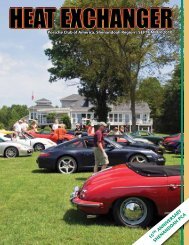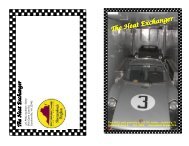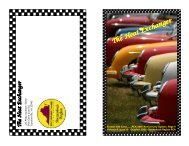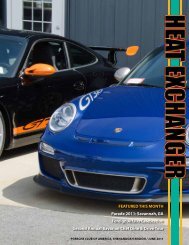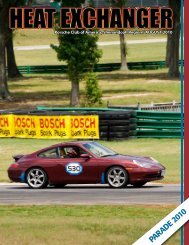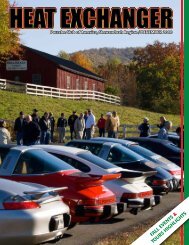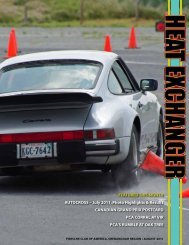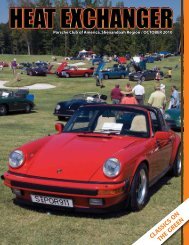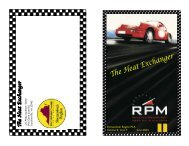Porsche Club of America, Shenandoah Region / APRil 2010
Porsche Club of America, Shenandoah Region / APRil 2010
Porsche Club of America, Shenandoah Region / APRil 2010
Create successful ePaper yourself
Turn your PDF publications into a flip-book with our unique Google optimized e-Paper software.
911 Rear Suspension Rebuild by Bruce Russell<br />
recently rebuild the suspension on my 1984 911 Carrera Targa.<br />
I I decided to start with the rear suspension since the rear had<br />
begun to “sag” a bit and I wanted to raise the rear suspension<br />
about 1/2". I would like to share my experience because this is<br />
a job most 911 owners with typical DIY skills can accomplish. I<br />
spread this job over a one-week period, but it could have been<br />
accomplished in a weekend <strong>of</strong> steady work.<br />
The first decision was what type <strong>of</strong> new rear suspension<br />
bushings to install. You basically have three choices for the rear<br />
end <strong>of</strong> the older 911’s. Your choices are poly-graphite bushings,<br />
poly-bronze bushings from Elephant Racing and Neatrix<br />
bushings. You notice I did not mention OEM rubber because<br />
the factory vulcanized the original rubber bushings to the spring<br />
plate and it is cost prohibitive for the average 911 owner to<br />
duplicate that process. Each <strong>of</strong> the three types <strong>of</strong> bushings has<br />
its “pros and cons”, but in the end, I chose the Neatrix bushings<br />
because my car spends most <strong>of</strong> its life on the street. Neatrix is<br />
fairly close in composition to the original rubber bushings, but<br />
are a little harder and wear a little better. A set <strong>of</strong> four Neatrix<br />
bushings cost about $65, which relative to the cost <strong>of</strong> most<br />
<strong>Porsche</strong> parts are a “deal”. For the rear sway bar bushings, I<br />
chose the factory original rubber bushings and new factory drop<br />
links.<br />
Before we dive into the actual work, let me mention some tools<br />
that I used. A standard set <strong>of</strong> metric wrenches and sockets is<br />
required. A floor jack and jack stands are essential. In addition,<br />
I also used a long ½” drive breaker bar, an angle finder, a shop<br />
vice attached to my workbench, a 22 mm allen wrench and a<br />
Propane gas torch. I will discuss their specific uses as we work<br />
through this project.<br />
The night before I started the project I sprayed all the nuts/<br />
bolts that would be removed with Kroil penetrating oil. I have<br />
been using Kroil for years and have always been pleased with<br />
the results. There are other good penetrating oil products (i.e.<br />
PB Blaster) on the market, but I prefer Kroil. In addition, I also<br />
removed the lower rocker panels and removed the round torsion<br />
bar cover plates from the body.<br />
The first thing I did was measure the ride heights at all four<br />
corners and the body inclination or “sweep” angle. The <strong>of</strong>ficial<br />
<strong>Porsche</strong> ride height measurement is fairly complex; I used the<br />
floor to fender lip method, which is close enough for me. With<br />
the angle finder, I measured the body sweep at the doorsill.<br />
Most experts recommend a 1-degree nose down sweep for a<br />
street car; mine was flat and thus the reason to raise the rear<br />
end a bit. I should point out at this point that I had already<br />
lowered my car about five years ago when I installed larger<br />
(22mm/28 mm) torsion bars.<br />
I jacked up the rear <strong>of</strong> the car and removed the rear wheels. I<br />
placed jack stands under the body pan just forward <strong>of</strong> the wheel<br />
well openings. I placed a piece <strong>of</strong> ½” plywood between the<br />
jack stand and the body pan to disperse the load. The final<br />
step before “surgery” was to mark the position <strong>of</strong> the toe and<br />
camber eccentrics so that you can get the rear alignment back to<br />
“ball park” settings upon reassembly. Make sure you mark the<br />
eccentric bolts and not the nuts! I used paint…YMMV.<br />
I now needed to remove the swing plate from the car. I<br />
should point out that I did one side first, before starting on<br />
the other side. This way I could use the undisturbed side as<br />
a reference if needed. Placing your floor jack under the lower<br />
rear shock mounting point and raising the rear suspension a ½”<br />
will facilitate the disassembly process. First out was the lower<br />
shock bolt. I used my long breaker bar on this nut because it<br />
is torqued pretty tight. Once the bolt is out, just let the shock<br />
hang free but keep the jack in place. Next out are the two<br />
19 mm trailing arm bolts and the toe and camber adjustment<br />
nuts and eccentric bolts (you already marked the position <strong>of</strong><br />
the eccentric bolts, right). I chose not to remove the height<br />
adjustment eccentric and tightening bolt because I had already<br />
set them in their center adjustment position several years<br />
ago. If you do remove these two nuts/bolts, be prepared for<br />
some heavy torque action (Hint – Kroil and the long breaker<br />
bar!). Finally, remove the lower rear bolt from the spring plate<br />
cover; leave the other three bolts in place for the time being.<br />
Note that the lower rear bolt has a spacer between the spring<br />
plate cover and the body…do not lose that spacer. I stored all<br />
hardware removed from the car in labeled Ziploc bags.<br />
The spring plate is now free from the trailing arm. I now<br />
lowered the jack supporting the rear suspension. Let it down<br />
slowly because the spring plate is under torque pressure from<br />
the torsion bar. I scribed a line (i.e. felt tip pen) on the inside<br />
<strong>of</strong> the wheel well along the top edge <strong>of</strong> the spring plate. This is<br />
just a visual reference line that shows the beginning inclination<br />
angle <strong>of</strong> the spring plate. I next measured the angle <strong>of</strong> the free<br />
hanging spring plate and wrote that angle down in my notes; the<br />
angle was 17.5 degrees. At this point, I want to digress and talk<br />
about suspension angles. The height <strong>of</strong> your rear suspension<br />
is a function <strong>of</strong> the size <strong>of</strong> your rear torsion bar and the spring<br />
Continued on pg 14<br />
What's the fastest growing class in<br />
PCA <strong>Club</strong> Racing<br />
SPBOX<br />
Build it. Buy it. Rent it...<br />
at WERKSTATT<br />
Look for us at the 17th Annual 48 Hours at Sebring !<br />
1117 C East Market Street Charlottesville, Virginia 22902<br />
T: 434.971.6700 F: 434.202.0316<br />
www.WERKSTATTCVILLE.com<br />
www.WERKSTATTCVILLE.com<br />
9



